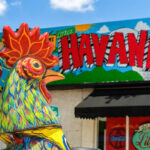Before the night life, cocaine cowboys and Miami vice, Miami originated from humble beginnings. The Homestead Act of 1822 was set up to populate the State of Florida, where Americans were given a plot of land of 16 acres if they stayed there for five years. And before that there were escaped slaves in the late 1700s who were transitioning to the Bahamas. There was a boom in the area with Henry Flagler’s railroads. With this railroad development there was a lucrative hotel industry. The other influential person was Henry Plant who connected the railroad from Jacksonville to Tampa. And the third person was Juliet Tuttle who came to Florida because she inherited Orange Groves. The infrastructure of the railroads, the cities and the building were built mainly by Black men. The city of Miami was incorporated in 1896 and the population grew steadily from500 to 30000 in 1920.
The building boom happened in the1920s in Miami and throughout the country as well. With this population boom, the city needed more land to build on. The Everglades were expanded and Miami Beach was founded in 1913 which was a great attraction for tourists. The golden age of tourism happened during the years of prohibition where consumption of alcohol was outlawed in the country in the 1920s. The city of Miami welcomed bootleggers and gamblers and Florida was the place to go and relax, to a have a drink, visit the beach and play a game a poker. This made for the real estate boom in Florida. This did not last however because of the setback of the hurricanes and the Great Depression of the 1920s. This crisis led to a lot of people being homeless and without jobs especially in the Black community.
The Black Community was also faced with restrictions and rules Their history has been an ongoing struggle of segregation, discrimination and equal rights due to Jim Crow’s laws. After the 1896 Plessy v. Ferguson decision, segregation became even more entrenched through a battery of Southern laws and social customs known as “Jim Crow.” Schools, theaters, restaurants, and transportation cars were segregated. Poll taxes, literacy requirements, and grandfather clauses not only prevented blacks from voting, but also made them ineligible to serve on jury pools or run for office. “Separate but equal” and Jim Crow remained unchallenged until Brown v. Board of Education in 1954 and the Civil Rights Act of 1964.
The Black community lived in a town called Overtown or Colored town and the living conditions were unsanitary and disease was rampant. When President Franklin Delano Roosevelt visited Miami in 1933, he was appalled what he saw there. He enacted the New Deal which was a series of programs, public work projects, financial reforms and regulations between 1933 and 1939. The programs focused on the 3R’s which were relief for the unemployed and for the poor, recovery of the economy back to normal levels and reform of the financial system to prevent a repeat depression. FDR authorized the construction of the Liberty Square housing project in 1933, the first of its kind in the Southern United States.
In the 1950s Overtown had a thriving Black community and was known as “Harlem of the South”. Like Broadway, Colored Town was buzzing with entertainment and it was “the Great Black way.” Nearly all of the arts were available in Colored Town through touring music, dance and drama groups as well as traveling literary artists, such as poet Langston Hughes and folklorist Zora Neale Hurston. Paul Robeson and Marian Anderson were among the featured vocalists; world-famous boxer Joe Louis and baseball greats Jackie Robinson and Roy Campanella also visited the area. Local residents jammed from dusk to dawn with entertainers Count Basie, Ella Fitzgerald, Cab Calloway, Lena Horne, Josephine Baker, Billie Holiday, Sammy Davis Jr., the Inkspots, Louis “Satchmo” Armstrong, Nat “King” Cole, B.B. King, Bo Diddley, Aretha Franklin, Dionne Warwick and many others who performed all year.
However, in the 1960s, the Historic Overtown neighborhood experienced a sharp decline due to the construction of two major highways through its center, demolishing more than 20,000 homes and displacing more than 40,000 residents. The result was a population that dwindled to less than 10,000 in this area.

